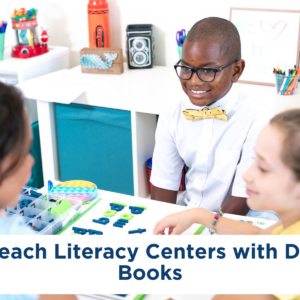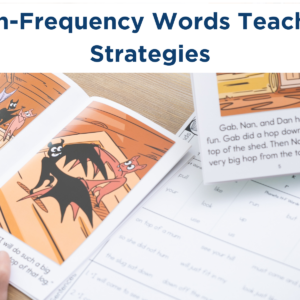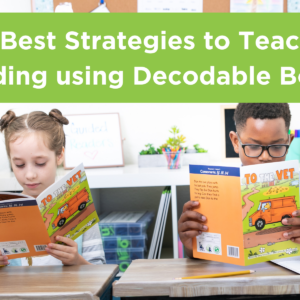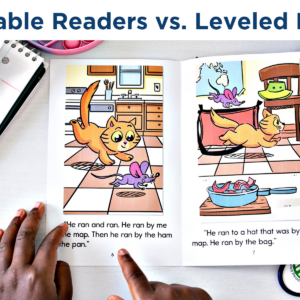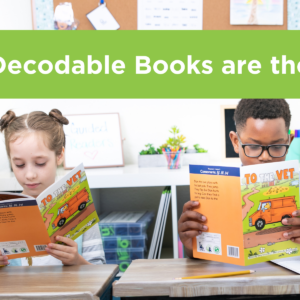Stop teaching children to read the wrong way. This is for you if you want your students to decode words and truly understand them. “Structured literacy” isn’t just another buzzword or pendulum swing. It’s the future of reading education.
As an educator, you’ve probably heard about different methods of teaching children to read, from phonics to whole language to balanced literacy. But I will unravel why structured literacy stands head and shoulders above the rest. It’s not just a better way to teach reading; it’s the best way to teach reading.
Structured literacy is the gold standard for reading instruction because it’s based on brain science and how the brain actually learns to read. So, I will share a few of the core principles and reasons why structured literacy is so effective for teaching all students, including those with reading difficulties like dyslexia, how to read.
It’s time that we rethink our approach to reading instruction.
1. The Cornerstone of Structured Literacy is Explicit and Systematic Instruction
Explicit and systematic instruction is the cornerstone of structured literacy. But what does that mean?
“Explicit” means that the teacher clearly explains and models key literacy skills for students. This helps break down the complex process of reading into small, digestible parts. So, we’re no longer expecting students to just pick up reading skills by osmosis. Instead, it ensures that children really understand each component before moving on to the next.
“Systematic” instruction refers to the orderly sequence of instruction that becomes the roadmap for teachers. For example, students begin by mastering simple consonant-vowel-consonant words like “tap” before advancing to more complex structures like those found in “stamp” or “tapped.” This building block approach has proven time and again to be effective.
Teacher-led instruction is central to explicit and systematic instruction, which allows immediate pinpointed feedback. This is a hallmark of structured literacy.
A scope and sequence is the most important part of structured literacy. Everything stems from it. If you don’t have an explicit and systematic scope and sequence or are unsure what it should be, we have a free one from Structured Literacy with E.A.S.E. that you can download HERE and use in your classroom.
2. Structured Literacy Uses a Phoneme-Grapheme Level Approach
Phoneme-grapheme level instruction also known as word mapping is a distinctive feature of structured literacy that focuses on the smallest units of sound, phonemes, and the corresponding written symbols, graphemes, or letters. It’s like teaching a child to read by first giving them the most basic building blocks and then showing them how they combine to form words.
Research shows that this approach is the most effective when compared to any other phonics approach. The phoneme-grapheme approach fosters meticulous attention to the sequence of letters in words, laying a strong foundation for decoding skills.
It’s not just reading; it’s about understanding the DNA of words, which is so important. This phoneme-grapheme-level approach creates a brain process called orthographic mapping, where the brain connects the graphemes and phonemes. It determines that they match together, so your brain learns what the string of letters says.
One of the phoneme-grapheme level instruction activities you can do in the classroom is called word mapping. Here’s a quick example of how it works. Let’s say your students are learning the high-frequency word “the”:

- Have the students repeat the word after you and then tap out the sounds in the word.
- Move two counters representing the two sounds up into the boxes on your Map-It paddle.
- Ask the students to say the first sound and move the first counter up while doing it.
- Ask your students what letters make the “th” sound. If they don’t know the answers, you can teach it to them.
- Have students tell you what the next sound is in the word “the.”
- Push the second counter up on the paddle.
- Ask students what letter makes that sound in the word “the.”
- Some students may think it’s the letter u. If so, you can say, “Yes, you’re right. U makes the sound, but all of the vowels make another sound. They all make the /ə/ sound also. So, A says /a/ and /ə/, which is called the schwa sound.” Quickly tell them about it and let them know that in the word “the,” the letter e is making the schwa sound.
- Draw a heart under the letter e on the paddle and tell students, “This is the part we learn by heart.”
If you’re new to word mapping, to help you, we include the mapping on the back of our high-frequency word cards in Structured Literacy with E.A.S.E. If you’re not sure how to map the words in the correct boxes, these cards lay it all out for you.
This is how you do word mapping. It’s a quick and simple way to map the sounds or phonemes to the letters or graphemes. You can learn more about how to do this activity by reading this article: Word Mapping: Linking Phonemes to Graphemes – How to Teach It
3. Why Structured Literacy Works for All Students
Let’s clear up a common misconception: structured literacy isn’t just for children with dyslexia or those who struggle with reading. It’s a universally effective method. However, the explicit and systematic nature of structured literacy is particularly beneficial for those who find reading challenging. It zeroes in on foundational literacy skills that many struggling students lack and offers them a lifeline to literacy.
Structured literacy’s teaching is clear, unambiguous, and directly targets the student’s needs, making it a very versatile tool for a diverse classroom. It has the power to really level the playing field, making high-quality reading instruction accessible to all, which is what we’re all striving to do as teachers.
4. There are Flaws In Our Current Literacy Practices
If structured literacy is so effective, why isn’t it the standard practice in all schools? Well, the truth is that many educational systems are stuck in the mud with outdated methodologies, and I’d like to discuss a couple of them.
Balanced Literacy
Balanced literacy is often touted as the best of both worlds, combining elements of the phonics and whole language approaches. It sounds great on paper, but it often becomes a jack of all trades, master of none situation.
While balanced literacy claims to offer a comprehensive approach, it lacks the explicit and systematic instruction that students need. It dilutes the focus on phonics and decoding, which are critical for early literacy development.
I was a balanced literacy teacher for 23 years. I taught using a flawed method, and it’s heartbreaking to me after what I’ve learned over the past three years. However, I believe I taught balanced literacy a little differently than most.
When I first started teaching, the school I was at was heavily phonics-based. It focused on very isolated skills and phonics instruction using worksheets and phonics but very little reading. The next year, I moved to another school in the district, and they used the whole language approach.
I quickly realized it wasn’t going to work because I was teaching children to read through a whole-word reading approach. I was sitting with students and realized that if they couldn’t sound out the words on the page, they wouldn’t be able to learn to read. By the second month of the school year, I realized phonics needed to be part of my instruction.
That’s when my instruction changed for the better for the rest of my career. I always taught with phonemic awareness and phonological awareness. I think these pieces were part of my instruction because I was one of the lucky ones. I taught through an isolated phonics approach and then through a whole language approach and saw that whole language wasn’t going to work.
While I always included phonics in my instruction, an explicit and systematic scope and sequence were still missing. I didn’t know I needed to teach the phonics sounds explicitly.
MSV Queuing System
There were so many parts of balanced literacy that I thought were wonderful like the shared reading, shared writing, and big books. All of those other parts can be amazing parts of a structured literacy classroom. But in my mind, MSV has become synonymous with balanced literacy.

MSV is a system that encourages students to use meaning, structure, and visual cues to identify words. For example, if a child encounters a difficult word, they might look at the picture on the page and consider what word would make sense in a sentence. While that may sound useful, it’s problematic for several reasons.
First, it encourages children to guess, which is not a sustainable strategy for reading. Second, it sidesteps the crucial skill of decoding, which is the backbone of true reading proficiency.
Both of these methods, balanced literacy and the MSV queuing system, can produce students who appear to read well on the surface. But when you dig a little deeper, you’ll find they often lack the foundational skills needed for advanced literacy tasks.
We need to equip our teachers with methodologies rooted in evidence and effectiveness while also preparing our students. Structured literacy does just that. It’s not just an alternative teaching method; it’s imperative for effective education.
5. The Time to Move to Structured Literacy is Now
We need to change the landscape of education and our instruction. 65% of American fourth graders read below the proficient level. This isn’t just a number; it’s a crisis with far-reaching implications for our society.
It’s about more than grades and test scores. It’s about equipping our children for life. Virtually all teachers want to be effective with their students, and structured literacy provides the roadmap that makes it possible.
The time for change is now, and the tool that will help make this change is structured literacy. So now, we need to empower each other and start making these changes and shifts in our classrooms.
We’ve covered the ins and outs of why structured literacy is the gold standard for teaching reading. From its explicit and systematic approach to the urgent need to rethink how we teach our students. But knowing is just half the battle.
If you’re a teacher or educator looking to implement these effective strategies, I’ve got something special for you. It’s a free scope and sequence designed to help lay out a very explicit and systematic roadmap for reading instruction, setting both you and your students up for success. Download it today to get started.


